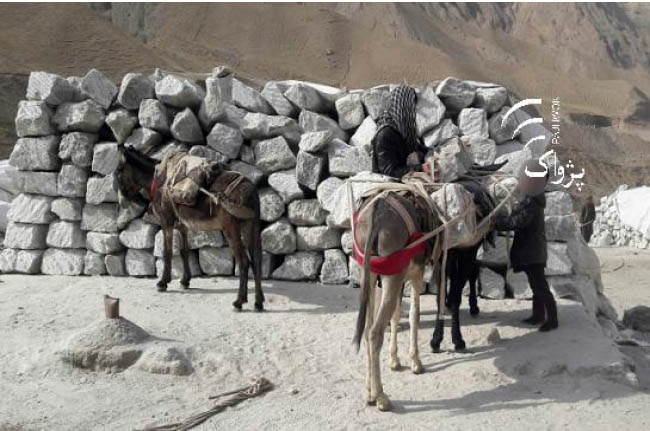TALOQAN - Mehrabuddin (not his real name), a 12-year-old boy, transfers salt rocks on two donkeys from dawn to dusk every day to pay off loan his father took two years ago in Namak Ab district of northern Takhar province.
Mehrabuddin, is among tens of children who are sent by their families to work as bonded laborers until the loans they have taken are paid off.
The 12-year-old hails from Namak Ab district. He goes to the salt mine with his two donkeys every morning and transfers the salt till the evening. He works more than 12 hours.
What law says in this case?
Article three, clause first of the Human Trafficking and Smuggling of Migrants 2017 Law says, “To recruit, transfer, transport, harbor or receive a person for the purpose of exploitation, using the means of deceit is human trafficking”.
Article 10 of the Human Trafficking and Smuggling of Migrants 2017 Law says, if the trafficked person is woman or child, the accused could be sentenced to eight years in jail.
A Pajhwok reporter, who traveled to Namak Ab district from Taloqan, Takhar’s capital, saw hundreds of children working in the salt mine.
They were below 15 years of age. Some children said they worked due to economic problems of their current family but others said they inherited work in the mine from their fathers and grandfathers.
One of the bonded child laborers said, his father borrowed 50,000 Afghanis from a salt trader two years ago because his father was ill.
He did not name the trader, but added: “He gave the amount to my father on the condition that I as a son has to transfer salt to him from the reservoir until the loan is returned.”
“My father is a mason, he cannot earn enough money to repay the debt,” he said, adding his father rarely found work.
“The father does not find work daily. I don’t know when the loan will be returned, I have to work with the salt trader till then,” said Mehrabuddin. When asked about education, Mehrabuddin said he had never been to school.
Few more children working in the salt mine were also victim of human trafficking into forced labor, but they refused to be interviewed.
Mehrabuddin’s father Fazal Haq, 40 (not real name), said he had tried hard in the past two years to repay the loan of salt trader but he was unable.
“I get work opportunity every second day or third day. After some days of work when I save some money to return the loan suddenly something happens in the form of illness or something else. I could not save money to free Mehrabuddin,” he said.
He added: “I can’t give you the name and address of the trader . He is a rich and powerful man, he may create a problem for me.”
Like Mehrabuddin, tens of other children have been working in the mine to pay off debts their elders have obtained.
The father of Mehrabuddin urged the government to help him return the loan.
Children working in mines develop many health problems: Health experts
Elham, head of Taqcha Khana Clinic of Namak Aab district, told Pajhwok that most of the district’s children were working in the salt mine.
“Salt extraction is not performed in a standard way or by machines and that is the reason many children got hurt”, he said.
“These children also do not receive the enough food, they suffer from many health problems including asthma due to lack of oxygen in mine’s caves and inhalation of salt’s dust,” he said.
He added such children also developed mental health problems because they suffered from labor pressure.
TIP High Commission: These activities are clearly Human Trafficking. Mohammad Hassan Salimi, a member of TIP High Commission told Pajhwok Afghan News, such activities are clearly considered as human trafficking and a crime. he added, this commission has raised the public awareness regarding these activities and the rest is the responsibility of the security forces to take action against it.
Above 90pc of Namak Aab children work in salt mine: Education officials
Basir Ahmad Ibrahimi, an educational supervisor in Namak Aab district, said most of the children in the district were working in the salt’s mine instead of attending school.
“There are five schools, including Tashblaq, Kham Khairan, Sarkan, Taqcha Khana and Akabi Shahid around this mine, but only 100 students attend each of them, he said.
“Each of these schools is built for 1,500 students, but more than 90 percent local children work in the salt’s mine instead of going to school,” he said.
He asked parents to send their children to school and not destroy their future.
Bismillah Waziri, children’s section head at the Afghanistan Independent Human Rights Commission (AIHRC) in the northeastern zone, said they had talked with families of children working in the salt’s mine.
“We met with families of these children and asked them to send their children to school and prevent them from working in the mine,” he said.
Waziri said the families had promised they would not send their children to the salt’s mine after two months.
Sayed Kazim Sadiq, Takhar labor and social affairs director, said hundreds of children were working in salt’s mines in Namak Aab and Kulfgan districts and in coalmine of Chaal district.
“Children work more but earn less money in these mines, the main reason behind it is poverty,” he said.
Sadiq said they had developed a joint plan with local officials for preventing children from working in mines in the next Georgian year.
According to Pajhwok Afghan News reports, currently nearly two million children are engaged in hard labor across the country. (Pajhwok)
Home » Afghanistan » Many Bonded Child Laborers Work in Takhar Salt Mine
Many Bonded Child Laborers Work in Takhar Salt Mine

